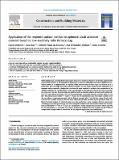Por favor, use este identificador para citar o enlazar a este item:
http://hdl.handle.net/10261/230965COMPARTIR / EXPORTAR:
 SHARE SHARE
 CORE
BASE CORE
BASE
|
|
| Visualizar otros formatos: MARC | Dublin Core | RDF | ORE | MODS | METS | DIDL | DATACITE | |

| Título: | Application of the response surface method to optimize alkali activated cements based on low-reactivity ladle furnace slag |
Autor: | Fernández-Jiménez, Ana CSIC ORCID | Fecha de publicación: | 2020 | Editor: | Elsevier BV | Citación: | Construction and Building Materials 264 (2020) | Resumen: | Steel-making slags, resulting from basic oxygen furnaces or electric arc furnaces are heavily applied in the construction industry, as an aggregate for pavements or concrete. Although possessing a significant crystalline content, it is expected that, if properly milled, the reactivity of these slags can increase up to a point when they are viable to produce alkaline cements. The aim of this study was the application of a response surface method to design the experimental work required to optimise the composition of an alkaline cement based on ladle furnace slag, a specific type of steel slag (SG). Fly ash (FA) was also added, in a precursor role, and the activation was achieved with an alkaline solution prepared with sodium silicate (SS) and sodium hydroxide (SH). The factors/variables considered were the activator index X = SS/(SS + SH), the precursor index Y = SG/(SG + FA) and the SH concentration (Z). The output variables were the unconfined compression strength and the flexural strength, after 7 and 28 days curing. Results indicate that the activator index (X) was the most influential variable, followed by the precursor index (Y). Microstructural analysis of selected pastes was also performed, using scanning electron microscopy and energy dispersive spectroscopy. The ideal composition obtained for the alkaline cement was the mixture constituted by X = 0.75, Y = 0.5 and Z = 10 (activator: 75% SS and 25% SH; precursor: 50% SG and 50% FA; SH concentration = 10 molal). This mixture achieved 8.70 MPa of flexural strength and 44.25 MPa of compressive strength which is reasonable for the required application (soil stabilisation). | Versión del editor: | http://dx.doi.org/10.1016/j.conbuildmat.2020.120271 | URI: | http://hdl.handle.net/10261/230965 | DOI: | 10.1016/j.conbuildmat.2020.120271 | Identificadores: | doi: 10.1016/j.conbuildmat.2020.120271 issn: 0950-0618 |
| Aparece en las colecciones: | (IETCC) Artículos |
Ficheros en este ítem:
| Fichero | Descripción | Tamaño | Formato | |
|---|---|---|---|---|
| Application of the response surface.pdf | 2,51 MB | Adobe PDF |  Visualizar/Abrir |
CORE Recommender
Page view(s)
78
checked on 18-abr-2024
Download(s)
280
checked on 18-abr-2024
Google ScholarTM
Check
Altmetric
Altmetric
NOTA: Los ítems de Digital.CSIC están protegidos por copyright, con todos los derechos reservados, a menos que se indique lo contrario.
